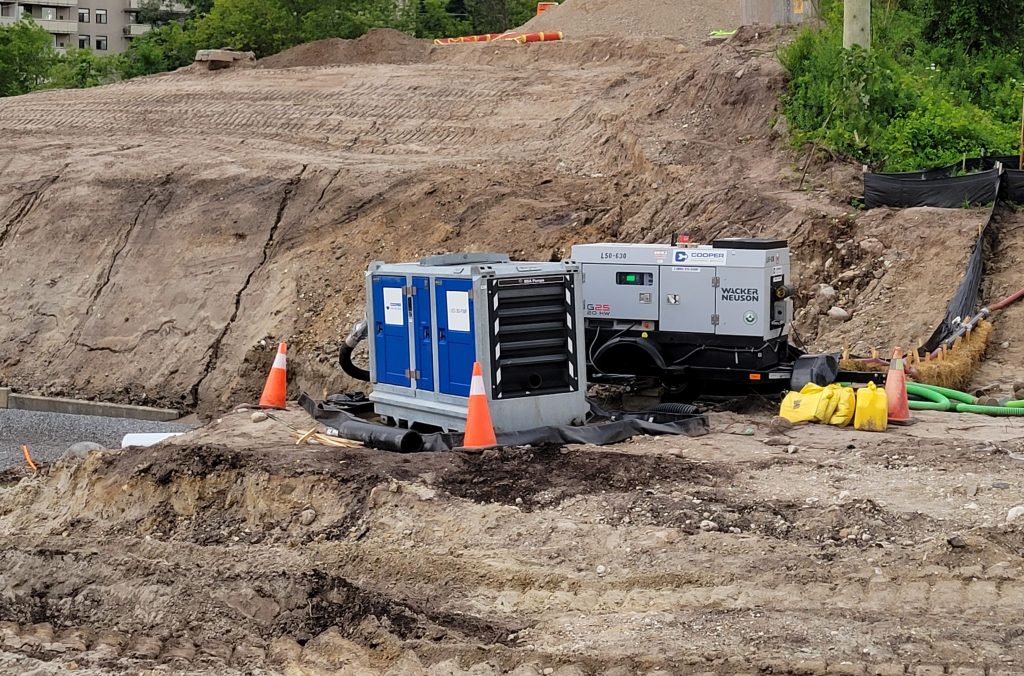Flood risks: An ounce of prevention is worth a pound of cure.
How does water creep into worksites and cause flooding? Let us count the ways.
There’s weather, for one thing. We can’t control nature and climate change is throwing us curveballs. Flash floods, surging rivers, spring thaws and cold weather combined with snow one day and temperatures above average the next. Yikes!
Then there’s all the other issues that can cause a flood…plumbing and mechanical systems, old water or sewage infrastructure and improper drainage.
Getting ahead of the risks before they become catastrophes can save you a lot of headaches. As Benjamin Franklin used to say, “An ounce of prevention is worth a pound of cure.” But it’s hard to be prepared when we don’t know what’s ahead of us. With all the daily challenges that come with running a construction worksite, you don’t need to add water damage to the list. Here’s a few ways you can prevent flooding on your worksite.
1.Assess your worksite and identify your risks
The first place to start is to identify how flooding could affect your workers, equipment, and site. Do your employees know how to safely handle equipment during a flood risk? What about electric equipment? They should, because water damage can bring your entire project to an abrupt halt – resulting in big challenges to your budget and timeline.
Avoid this by storing all equipment above the floodplain when not in use. If it’s too late and equipment is already in water, contact your equipment provider right away. The right procedures can make all the difference when it comes to keeping workers safe and recovering construction equipment.
2. Look at your good, better and best scenarios
We plan for various risks on site, and flooding should be one of them. It’s just good practice. A plan that can be quickly implemented may mitigate serious water damage with very little impact on the budget.
There’s no perfect solution when it comes to flood prevention. It involves a mix of planning, preparation….and the right equipment. Striking the balance between potential risk and budget is key – this is where looking at best and worst case scenarios can come in handy. Remember to be flexible – your plan may change along the way depending on the stage of your construction process.
3. Make sure you’ve got proper drainage
We all know the importance of proper drainage on a worksite….especially if your site involves large-scale digging and deep trenches. These areas can be prone to flooding, especially during periods of heavy rain. If not properly managed, excess water can cause erosion, muddy soil, and even landslides which can lead to equipment damage.
If you’re working with trenches, it’s important that your team is also aware of how to protect themselves and other workers. Extra safety measures are critical when working with trenches. Trench collapses can result in serious injuries or worse. The wellbeing of your workers is worth the investment in trench safety and at Cooper we have a whole team dedicated to this very thing.
4. Get the right equipment in place before the job starts
Water management and construction should go hand in hand. Time is money and resources are finite. Ensuring you have the right equipment in place before the job starts means you’re prepared to handle almost any type of water situation from a collapsed sewage system to a water main break.
If you need flood relief, large dewatering and sewage pumps can clear water quickly and efficiently and are designed to work under tough conditions. For small-scale water removal, there are many solutions that are more economical but equally as reliable.
5. Lean on your rental partner to ensure you have what you need, when you need it
We get two types of phone calls. The first is a customer needs an assessment and equipment plan to help prevent flooding on their worksite. The second goes a little like this…. “We’re under water, send help immediately!” For most customers, once they’ve been burned with a flood once, they don’t let it happen again.
So if you’re looking to prevent flood damage before it happens make sure your rental partner can provide the best solutions. They should be on board to support your business – helping identify potential challenges that may arise along the way. And don’t forget to engage them from the beginning of your construction process. This way you can mitigate flood risks and sleep a little better at night knowing your rental partner has your back.
To find out more about our flood solutions, contact our Pump & Power team.

0 Comments